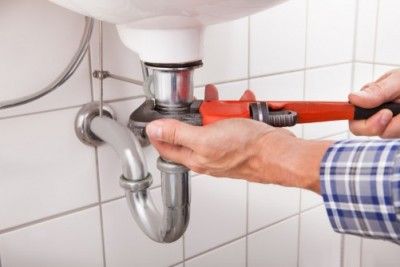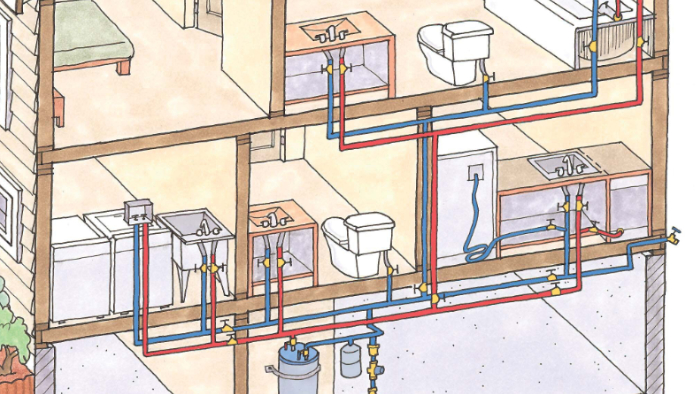Understanding The Anatomy of Your House's Plumbing System
Understanding The Anatomy of Your House's Plumbing System
Blog Article
The author is making a few good pointers relating to The Inner Workings of Your Home's Plumbing overall in this article down below.

Recognizing exactly how your home's pipes system works is vital for every single property owner. From supplying clean water for drinking, food preparation, and bathing to safely removing wastewater, a properly maintained plumbing system is important for your family members's health and wellness and comfort. In this extensive guide, we'll check out the complex network that composes your home's pipes and deal pointers on upkeep, upgrades, and handling common issues.
Introduction
Your home's plumbing system is more than just a network of pipelines; it's an intricate system that ensures you have access to clean water and efficient wastewater removal. Knowing its components and how they work together can aid you protect against pricey fixings and make certain whatever runs smoothly.
Basic Components of a Plumbing System
Pipelines and Tubes
At the heart of your pipes system are the pipelines and tubes that bring water throughout your home. These can be made from different materials such as copper, PVC, or PEX, each with its advantages in terms of resilience and cost-effectiveness.
Fixtures: Sinks, Toilets, Showers, and so on.
Components like sinks, bathrooms, showers, and bath tubs are where water is made use of in your house. Recognizing exactly how these fixtures connect to the plumbing system helps in diagnosing problems and planning upgrades.
Valves and Shut-off Points
Valves control the flow of water in your pipes system. Shut-off shutoffs are critical throughout emergency situations or when you require to make fixings, enabling you to isolate parts of the system without interfering with water circulation to the whole residence.
Water System
Key Water Line
The major water line attaches your home to the local water system or a personal well. It's where water enters your home and is distributed to various fixtures.
Water Meter and Pressure Regulatory Authority
The water meter actions your water use, while a pressure regulatory authority guarantees that water moves at a safe stress throughout your home's pipes system, stopping damage to pipes and components.
Cold Water vs. Warm water Lines
Comprehending the distinction between cold water lines, which provide water straight from the main, and hot water lines, which lug warmed water from the hot water heater, helps in repairing and preparing for upgrades.
Drain System
Drain Piping and Traps
Drain pipelines bring wastewater away from sinks, showers, and commodes to the drain or septic tank. Catches stop drain gases from entering your home and also catch particles that can cause obstructions.
Ventilation Pipes
Air flow pipes allow air right into the drain system, preventing suction that can slow down drainage and create traps to vacant. Appropriate ventilation is crucial for preserving the integrity of your pipes system.
Significance of Correct Drainage
Making certain appropriate drainage protects against backups and water damages. On a regular basis cleaning drains pipes and keeping traps can stop costly repair work and expand the life of your pipes system.
Water Furnace
Types of Water Heaters
Water heaters can be tankless or standard tank-style. Tankless heaters heat water as needed, while tanks keep heated water for instant usage.
Upgrading Your Pipes System
Reasons for Updating
Updating to water-efficient fixtures or changing old pipes can boost water quality, minimize water bills, and raise the value of your home.
Modern Pipes Technologies and Their Advantages
Explore modern technologies like clever leak detectors, water-saving bathrooms, and energy-efficient hot water heater that can save money and lower ecological impact.
Cost Factors To Consider and ROI
Determine the ahead of time costs versus long-term savings when considering plumbing upgrades. Numerous upgrades pay for themselves with minimized energy expenses and less fixings.
Just How Water Heaters Connect to the Pipes System
Recognizing how water heaters connect to both the cold water supply and hot water circulation lines helps in identifying problems like not enough hot water or leaks.
Maintenance Tips for Water Heaters
On a regular basis purging your water heater to remove sediment, examining the temperature level setups, and evaluating for leakages can expand its life-span and improve energy efficiency.
Typical Pipes Concerns
Leakages and Their Reasons
Leakages can occur as a result of maturing pipes, loose fittings, or high water stress. Addressing leaks immediately stops water damages and mold and mildew development.
Obstructions and Clogs
Clogs in drains and toilets are frequently caused by flushing non-flushable items or an accumulation of oil and hair. Making use of drainpipe displays and bearing in mind what goes down your drains can prevent clogs.
Signs of Plumbing Problems to Watch For
Low water pressure, slow drains, foul odors, or unusually high water costs are indicators of possible pipes issues that must be attended to without delay.
Pipes Upkeep Tips
Routine Assessments and Checks
Schedule yearly plumbing evaluations to catch issues early. Seek indicators of leaks, rust, or mineral buildup in faucets and showerheads.
Do It Yourself Maintenance Tasks
Simple jobs like cleansing tap aerators, checking for toilet leakages making use of color tablets, or insulating revealed pipelines in chilly climates can stop major plumbing concerns.
When to Call a Specialist Plumber
Know when a pipes concern needs professional proficiency. Trying complicated repair work without proper expertise can cause more damages and higher fixing expenses.
Tips for Reducing Water Use
Easy behaviors like fixing leakages quickly, taking shorter showers, and running complete loads of washing and dishes can preserve water and lower your utility costs.
Eco-Friendly Plumbing Options
Take into consideration lasting plumbing products like bamboo for flooring, which is durable and eco-friendly, or recycled glass for counter tops.
Emergency Preparedness
Actions to Take During a Pipes Emergency
Know where your shut-off shutoffs are located and how to shut off the water supply in case of a ruptured pipe or significant leak.
Significance of Having Emergency Situation Get In Touches With Convenient
Keep get in touch with information for regional plumbing professionals or emergency solutions conveniently available for fast reaction throughout a plumbing dilemma.
Ecological Effect and Preservation
Water-Saving Components and Appliances
Setting up low-flow taps, showerheads, and toilets can dramatically decrease water use without sacrificing efficiency.
Do It Yourself Emergency Fixes (When Suitable).
Short-lived solutions like using air duct tape to spot a leaking pipe or putting a container under a leaking tap can lessen damage until a specialist plumber arrives.
Final thought.
Recognizing the makeup of your home's plumbing system equips you to keep it effectively, saving time and money on repair work. By complying with normal maintenance routines and remaining educated concerning modern plumbing innovations, you can ensure your pipes system runs successfully for years ahead.
Understanding Your Home Plumbing System: A Comprehensive Guide
Plumbing System: The Lifeline of Your Home
At its core, the plumbing system is designed to perform two primary functions: bring fresh water into your home and remove wastewater. The system is a network of pipes, fixtures, and other components that transport water and sewage. Residential plumbing systems include potable water supply lines, drain-waste-vent (DWV) systems, and various plumbing fixtures that make water use in daily tasks possible.
Key Components:
Water Supply: This part of your plumbing system brings municipal water into your home, passing through the main water supply line. It s responsible for supplying all water needs, from drinking to bathing.
Drainage System: It carries waste and water away from your home to the sewer or septic system. This system includes all the piping within your home that leads to external sewage or septic systems.
Vent System: An essential yet often overlooked component, the vent system allows sewer gases to escape and lets air into the drainpipes, ensuring water and waste move correctly through the system.
Fixture: More Than Just Taps and Toilets
Plumbing fixtures are the most interactive parts of the plumbing system, including faucets, showers, toilets, and sinks. Each fixture is connected to the plumbing system and plays a role in either the delivery of freshwater or the disposal of waste and wastewater.
Types of Fixtures:
Faucets and Sinks: Used for washing hands, dishes, and other daily water needs. Toilets: Dispose of human waste through the sewage system. Bathtubs and Showers: Provide bathing facilities, requiring both hot and cold water supply. Water Supply: The Source of Life
The water supply system is a critical component, ensuring that potable water is available throughout your home for various uses, including drinking, cooking, and cleaning. This system consists of pipes that distribute water to different parts of the house, controlled by valves to regulate the water flow.
Types of Plumbing: Materials and Methods
Various types of plumbing systems and materials are used in residential settings, each with its advantages and applications. From copper and PVC pipes for water supply to cast iron and ABS for drainage, the choice of materials can impact the longevity and efficiency of your plumbing system.
https://intownplumbingtx.com/articles/home-plumbing-system-guide/

Do you appreciate more info about Understanding Your Home's Plumbing Anatomy? Post feedback down the page. We would be happy to hear your ideas about this write-up. Hoping that you visit us again in the near future. Sharing is nice. One never knows, you could be doing someone a favor. We recognize the value of reading our article about Plumbing Installation 101: All You Need to Know.
Call Today Report this page